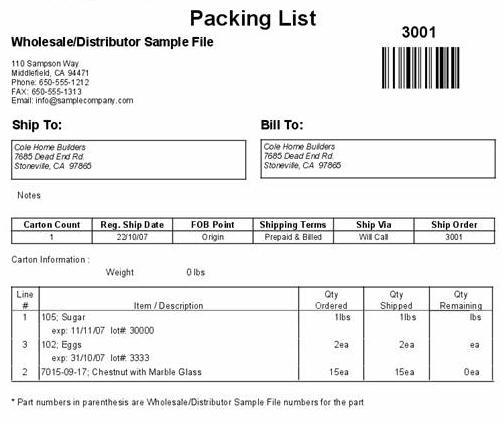The export packing list, which may be shown on the commercial invoice or separately, should contain item by item, the contents of cases or containers or of a shipment’s cases, with each item listed separately and with its weight and description set forth in such a manner as to permit a check of the contents by the customs on arrival at the port of destination as well as by the importer. The export packing list must be made in accordance with the instructions of the customer. Great care should be exercised to make certain that the contents of the packages are exactly as indicated in the export packing list. Any variation from what is shown in the export packing list, commercial invoice, or consular invoice may, and usually does, render the consignee liable to heavy fines.
In short, in the matter of packing for overseas markets, the exporter should take into account not merely the preference of the foreign buyers and users but also the original purpose of packaging, namely, the preservation, protection and proper presentation of the goods. The preservation of the quality of the contents is the most important aspect of packing, which the exporter should always bear in mind. Different types of goods require different types of export packing to preserve the quality of the contents; for instance in order to preserve the quality of pepper and cashew nuts, it may be necessary to pack them in moisture-proof polythene bags or tin containers. Similarly, food articles have to be packed very carefully and in sanitary cans.
It should be borne in mind that goods meant for export have to undergo severe hazards in transit, for they are loaded and unloaded at various stages. The size of the packing has also to be taken into consideration. At certain points, for instance, at some ports, packages only of a certain maximum size can be conveniently loaded and unloaded.
The exporter should also give due thought to the presentation of the contents. The packing layers, next to the contents, have to be attractive; and it is here that the exporter should take into account the preference of the buyers in a particular country. The contents of the different packages should be uniform as far as possible, in order to facilitate the assessment of the quantum of the goods with reference to the number of packages.
The main object behind making export packages is to identify the cargo. Normally, ships carry a large number of consignments belonging to various exporters. If adequate identification marks are not placed on goods, it would be really difficult to identify the consignments of each exporter. In order to facilitate the inspection of the goods by the customs authorities and their quick and effective delivery at the destination by the railway and shipping authorities, it is essential that the exporter should avoid a multiplicity of markings and, at the same time, put legible markings, preferably printed and of adequate size on the packages. The marks should correspond with these on the shipping documents and invoices. Marking should be in an international language, say, English; in addition, such other markings as are required under the regulations of the country of destination may also be placed on cases and/or packages.
In the case of goods which require to be specially handled, such instructions should be given on the packages as: “Stow away from boiler”, or “This side up”, etc. These instructions apply to markings on the outer cover of the packages. Markings on the inside packages containing the goods are essential partly from the advertisement joint of view (since they indicate the name of the country and possibly that of the manufacturer or exporter) and partly under regulations under the Merchandise Marks Act. In marking the goods, the exporter should ensure that their appearance is enhanced and that no part of the goods is wasted.
Generally speaking, the standards fixed under the various quality control schemes provide for standardized packing and marking. This should be adhered to by the trade. An important point to remember here is that arrangements for obtaining the delivery of the goods from the manufactur ers, their transportation to the port and loading on to the ship require to be dovetailed into the procedure for preshipment inspection, for any disloca tion at the inspection and is likely to throw out of gear the other arrangements of the exporter.
